
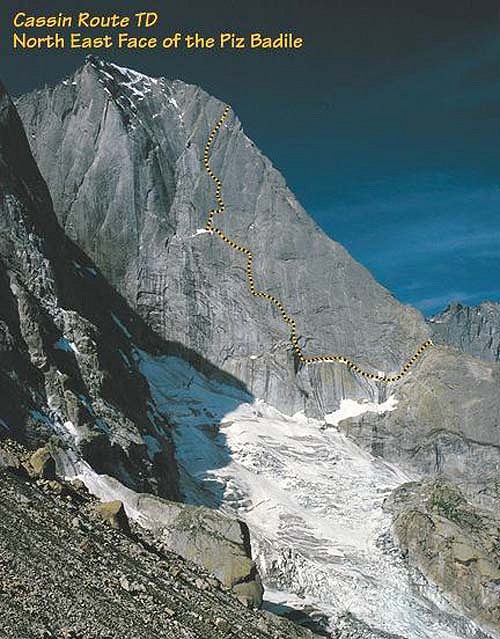
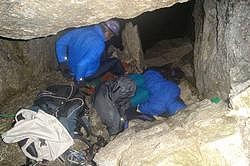
How did we arrive in this situation?
Ten years ago we had set out with the intention of doing the infamous Cassin Route on the North East Face of the Piz Badile. Weather defeated us that year absolutely: we never even saw the mountain, but had instead embarked on a six day tour running from Finale Ligura on the Mediterranean to Yellow Edge in the Dolomites. Two years ago was even worse: we never even got into Switzerland where floods in Interlaken even made the UK National news. But we did discover the beautiful and unspoilt Ubaye area in the Alpes de Haute Provence.
This year, avid scanning of the Internet for the local forecasts of our chosen week suggested that initially the weekend weather would be bad. But it looked as if the rain might stop on the first Sunday and stay fine for three days perhaps with more good weather to come at the end of the week. Our spirits rose with the barometer.
As usual, the lads turned up for a meal in Faversham around 8pm. Chicken curry this year with, of course, a side salad for Jim. Jim demonstrated the extent of his training and how fit he was by breaking my nutcrackers. Such an exhibitionist.
The team were myself, Jim, Ken and John – all now well into our fifties (ok Jim has only just got the tee-shirt) but still pretty active. Tough as it is to be away from family, they pressurise us into putting up with at least a week of suffering every Summer.
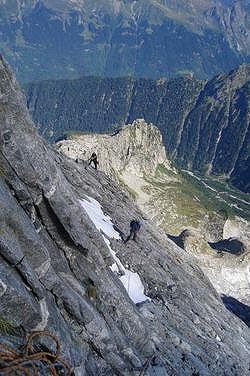
We arrived in Alsace for breakfast with the storks at Munster (a must see) and then spent the day at Martinswand – a fine one to three pitch granite crag in the Vosges, recently featured on UKClimbing.com Forum. A “to be recommended” journey break or poor weather option on the way to Switzerland. When rain stopped play in the afternoon, we moved on and enjoyed an evening meal in Baden in Northern Switzerland. It was raining hard now. Campsites were elusive despite the use of our extensive linguistic skills (not!) on the locals. Wearily, we eventually succumbed to a (better whisper it!) - Zimmer Frei. To misquote WH Murray: "On a climbing trip, like the Queen of Spain's legs, a hotel not only ought never to be contemplated, but must not be supposed even to exist."
I was dreaming deeply about slugs in my kitchen (that's another story) when there was a pounding at the door. Having slept for a solid 10 hours, following the overnight drive, we were on the verge of missing breakfast. I think I could cope without camping. As it turned out we never put the tents up all week.
The forecast in the local newspapers, was bad for Sunday in the Engadine, but improving late in the day. The gear was sorted in the hotel car-park during a dry spell in order to be ready to walk up to the Sciora hut at the end of the day. The drive to South East Switzerland was through driving rain but we were in intellectual mode to pass the time. Sample questions from the “on going” Pop Quiz:
Who sang the following:
“Wheels of Fire”
“Micky”
and (seriously sad now)
“Little White Bull”
St. Moritz and the Engadine valley materialised around 2 pm, and
At the parking spot in Bondo we paid the toll, happy to avoid the long trudge up to Laret. There were still two hours (or two and a half for me) of splendid ascent to the Sciora hut with ever expanding views of impeccable granite peaks picked out in the evening sunshine. We were greeted with welcome food and rewarded with a splendid sunset.
The Sciora provided our first views of the objective across the Cengalo glacier. Impressive. At least a couple of days were needed for the North-East face to dry out. The past week's bad weather had given snow high up and there were marked water streaks in the lower half caused by seepage.
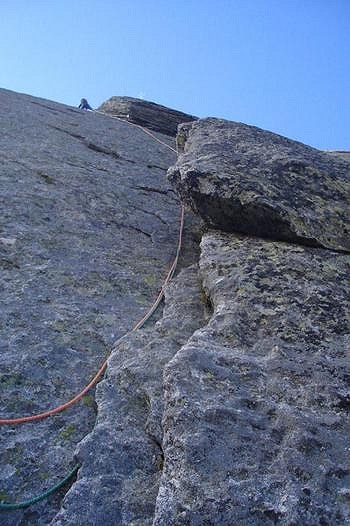
Despite a late start for such a long climb we struggled up the interminable boulder field and got stuck in. All was fine till until the “big black dripping overhang” marked clearly in the topo. It was living up to its billing. The traverse alternative into a precarious gully looked even more unwelcome than the overhanging wet roof. The approach slab was running with icy water but it was very character building, and, after a few false leads, I finally got installed at a belay under the dripping monster. It took some time but the others were quite pleased for me to lead the way judging by the comments (and distinct lack of volunteers) from below.
The overhang was a snarling monster and dripping wet. After trying to surprise it by sidling in from the right, and with encouragement from below, a swift pull on a quick-draw resulted in a haul over the lip. The others followed the same example – some with a foot sling for added comfort. Above, all was sweetness and light and slabby with 4a/b cruising all the way to the top. But the day was getting on by now and starting a 23 pitch route by getting up at 7.30am was not conducive to avoiding benightment. A halt was called around pitch 18 and a moral ascent claimed. The abseil descent went smoothly getting us back to the hut with 10 minutes daylight and in good time for supper. The result had come from an excellent mountaineering decision and was good preparation for the days to come.
The consensus was now to spend the Tuesday walking leisurely over to the Sasc Fura hut, from where the walk in to the Badile was considerably shorter. Our tactics were settled. We would pause at the Viel pass on the continuation of the North Ridge of the Badile. Here we would leave our non-climbing gear temporarily and carry the essentials for the climb up to the point close to the Niche on the North ridge frequently used as a bivvy site. There had been a long and hard debate on whether to bivvy out but the prospect of a comfortable night with minimum gear to walk up in the morning- i.e., just a head torch – was the clear preference. From the start of the scramble, where we stashed the sacks, Jim couldn't resist a quick sortie up to the notch where the traverse to the start of the North-East face begins. He was soon back with reassuring noises about how it looked. We descended to the Sasc Fura hut with the remnants of our gear and had a leisurely afternoon washing socks and various body parts which were in much need of strong soap.
That evening the alarms were set for 3.45am. I can report that the condemned men breakfasted well on bread jam and coffee the following morning along with about eight other early risers, who might have been potential competition for our route. In fact they were mostly after the North Ridge.
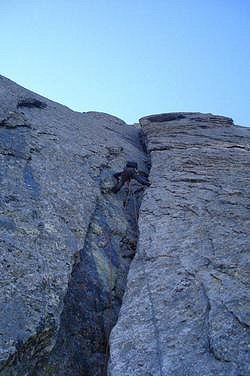
It was Jim and John's turn to be in the lead. They set off down from the notch, roping up early and then crossing the traverse where, although it is easy, care is needed to belay when appropriate and avoid the small quantities of snow. It had already been established that ice gear was not required and so normal walking boots were carried. Everyone climbed with their own very light sacks rather than one between two which had been our previous practice. This turned out to be a good decision – it saved time at belays and we barely noticed them.
The Italian party ahead was just starting the first easy chimneys moving reasonably quickly. The first corner (Rebuffat's variation avoiding the hard looking slabs on the left) passed easily. Early morning sunshine lit the face as Ken led the photogenic curving crack of the second main pitch. An easy rope-length up through a gap led to the first crux pitch. Here, the Italians slowed down a bit. It was a beautiful intricate side-stepping sort of pitch, sidling up to and round overhangs and then out across slabs. Great climbing at around English 5a. The first crux over, our confidence increased.
The Italian youths now got a bit off route aware of the need to move left at some point but got lured away too early by a tempting overhang on the left. In fact, the route went more up and right before moving up and only then traversing well left towards the remnants of the snow patch below the second crux. Jim and John managed to overtake using a smart route correcting manoeuvre – “Take him John, take him” was the sotto voce urging from Jim. Ken and I got alongside the Italians but had to back off under braking as we approached the stance. In fact, we needn't have worried because the Italians waved us through at the stance. A Portuguese team had also caught up and 7 people were now gathered to watch Jim grapple with the real crux.
The corner crack was a beauty soaring up towards some daunting overhangs. Jim's inimitable gruntings (as ever) gave no real clue either to how hard or good the pitch was but he ran out of rope as he reached some sort of contrived stance.
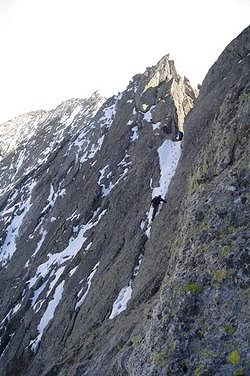
Beautiful flake and groove climbing led up to the third crux pitch which was passed via an undercling, padding on the slabs to reach a groove to the left. This was well provided with pegs and went at around 5a. During Ken's previous epic ascent, there had been a rather unpleasant episode at this point during which Ken's partner had demonstrated involuntarily how to do a “Paula Ratcliffe” while hanging in etriers. Happy days! No nerves this time though.
One more long, 80 metre, pitch up and left led into the groove line leading to the exit chimneys. We ran two more pitches together belaying below the ominous first chimney pitch. At this point the sun disappeared over the East ridge leaving us in the shade. I breathed a sigh of relief as Ken passed me, taking the gear unquestioningly and not asking me to lead it. It was wet and a bit of a brute with fresh snow in the bottom. John's large footprints showed we were the first parties up for quite some time. A combination of technical bridging and awkward back and footing with a sack on led into the bed of the gully. The next pitches were looking unpleasant and they were slowing Jim down. When I got to them I understood exactly why. They were black, brooding and running with water. Technically not too hard, they required great care to find the best holds and avoid slipping off. Very old pegs, rotten wooden wedges and occasional modern nuts provided some moral support. At the top of the third chimney pitch, good moves on dry rock led briefly onto the left wall before returning to the chimney line and then moving back into the sunshine above the difficulties.
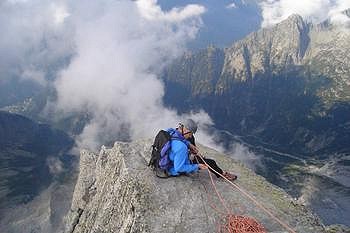
The plan previously agreed was that in order to abseil down the North Ridge then ideally we wanted to be on top by 4pm to allow for the four to six hour guide book time. Our arrival was an hour and a half later. Tempting as it was, we didn't really want to bivvy half way down the North Ridge so set off upward, along the ridge, intending to get down from the summit to the Gianetti hut on the Italian side for the night via a two and a half hour descent The ridge to the top was entertaining up pinnacles and down deep gaps. There was a final plod up a snowy groove to the actual summit ridge. At the top there was a weird cone in memory of Esposito who died during the epic first ascent.
There is a bivouac hut near the summit but we knew the parties following might well need it and it only sleeps 4. Although the summit ridge had proved time-consuming, English manners dictated that we stick with our plan to get down the South side of the mountain if possible. There was little time to spare. Clouds were gathering, light was beginning to fade and we knew the way down was complex. Having descended the initial steep path we found the abseils and started down. Tantalising glimpses of the Gianetti hut's red roof appeared regularly through the bubbling clouds. Our objective for the night was still far, far below. Five rappels later, a gully led down to where the path went off to the West. It was nearly dark by now. The guidebook told us to look for “Kruez” but our German language skills didn't allow an understanding of the meaning. Just beyond a sort of through cave (created by a large slab over the path) was a further abseil station but disturbingly not equipped with the usual massive ring-bolt. Jim abseiled down into the gloom from a mass of ancient tat and looked around. Clearly this was a way down of sorts but not our intended route and it was nearly pitch dark.
Discretion overcame valour and so he came back up and we settled down to bivvy.
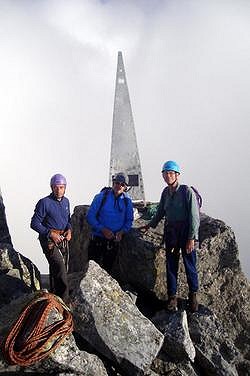
Intermittent rain, snow and the light show continued and we shivered our way through to a long drawn out dawn. Finally, it was light enough to make a move and we packed up again in good spirits. Reversing our steps, the real descent route was now obvious from the cairns going upwards from the more obvious path. The “Kruez” was a big metal cross commemorating an early ascent and served as an abseil station. Two rope lengths and we were down the mountain and heading off across the boulder field to the hut.
Once safely on easy ground, the weather eased and the sun even shone temporarily. The Gianetti hut had many pictures of Cassin himself on the 50th anniversary ascent. We were pretty sure that, in our unshaven states after a tough night out, we looked nearly as hard as he did.
A long, leisurely, breakfast preceded the interminable trudge back over the two passes to the Sasc Fura hut. Soon after leaving the Gianetti, we were relieved to see the Italian pair descending the moraine from the mountain.
Nominally a five hour walk, it took us considerably longer to get back. The Trubinasca Pass seen from a distance reared up as the final barrier. Its steepness was overcome with solid chains on both sides which were very welcome. At the top of the pass thunder, lightning and rain really set in but, by now, we were walking (well stumbling really in my case) on air. The long traverse round to the hut was endless and the final rise up through the trees was an unwelcome sting in the tail.
It was wonderful to be back at the Sasc Fura though. In retrospect, the completeness of the experience was made by the combination of an early start, a superb long route, the summit ridge, the summit itself, the enforced bivvy and the long walk back: all those events in one thirty six hour session.
After a few hours Lorenzo and Gabriele, the Italian climbers, arrived safe and sound. It turned out they had used the bivouac hut on the top, having phoned a friend to ask its whereabouts. They described a horrendous descent down the line of abseils we had attempted in the dark. It was reassuring that they missed in broad daylight the path we lost in the dark.
We indulged in a much metaphorical backslapping and mutual self-congratulation, washed down with several Grappas and Café Trubinascas – coffee laced with Amoretto. Bliss.
The next day after a long lie-in, we wandered down to Bondo with the mountain looming behind our shoulders as a reminder. There really didn't seem much need to do anything else - anticlimax might follow. But we had Jim in the party!!
With two days left the last two nights were spent in the Albigna hut. The slab routes nearby succumbed on our way to the hut during the afternoon. With a changeable weather forecast suggesting afternoon “horage” Jim and I teamed up to climb Via Classica and Via Miki on the Bio Pfeiler, while Ken and John did Modern Times on the Albigna across the valley.
My hands were now really suffering. Training by tapping fingers on a keyboard in an office was not enough to harden my finger tips to 70 odd pitches of rough granite in 7 days. The blood was showing through in several places and the slightest knock was agony.
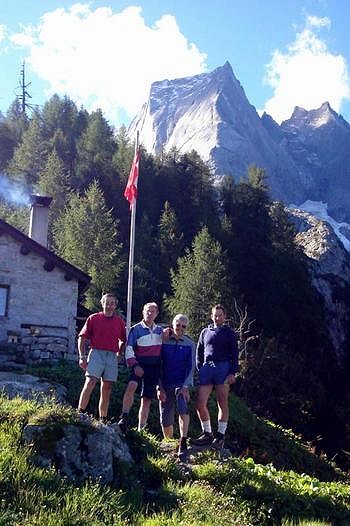
Timing was perfect and we caught one of the last lunch time lifts down to join Ken and John. There was just time for a wash in the river before the heavens opened again: right on cue.
Our timings for both arrival and departure had been perfect. It was the trip of a lifetime.
Now: how to follow that when the families kick us out next Summer!
Quiz Answers
Brian
Auger, Julie Driscoll and the Trinity
Toni Basil
Tommy Steele
Some more Cassin Route resources at:
Malcolm Phelps is 57 years old. Been climbing since 1968. Brought up on the Avon Gorge. High points in cragging were Krapp's Last Tape and the Medlar with Jim Unwin in 1975 but nothing more than E2 since! Favourite UK area is Pembroke. Scariest climb Preposterous Tales. Most recent harder route Deep Space which I led in appalling style earlier this year. In recent years the four of us from way back - Jim Unwin, Ken Goodman and John Dennis have managed a Summer week or two's trip to places like Yosemite, Pyrenees, Picos de Europa, Dolomites and Swiss Granite. We're after the big mountain rock routes but not averse to clipping the odd bolt or seven and then having a good moan about how safe it all is these days. Next year might go for that long granite route in the Pyrenees which featured in an UKClimbing.com article recently"








Comments